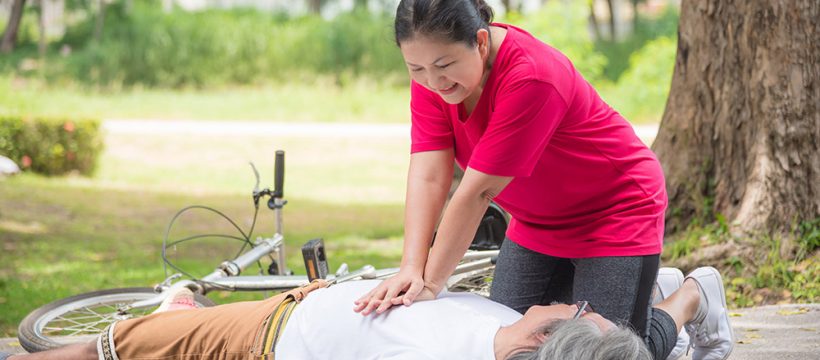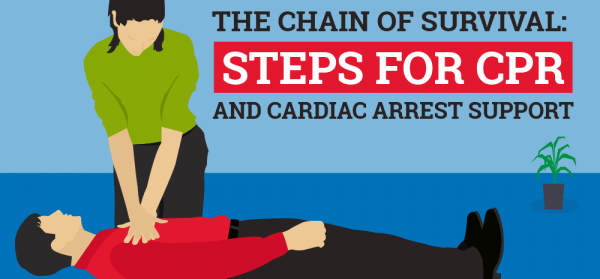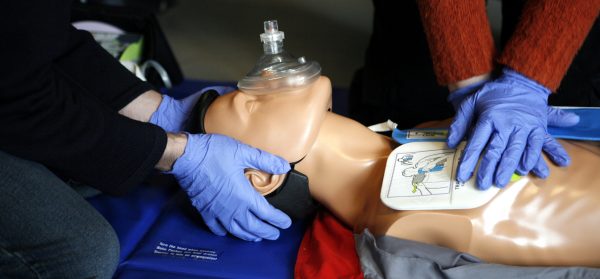
CPRNM® is a comprehensive directory designed to connect individuals and employers with top-tier training
providers including the AHA®, Red Cross®, and other training providers.*
Research has shown that nearly half of the patients who experienced cardiac arrest outside of a hospital setting survived when a bystander administered CPR. Understanding how to do CPR and basic first aid can be a literal lifesaver in an emergency. Even if you’re able to call for help, those first few moments before help arrives can be the difference between life and death. Prepare yourself to render aid by reading the complete beginner’s guide to CPR and first aid.
Looking for Local CPR and First Aid Training?
What Are the Steps for CPR?
Learning the steps for CPR can help keep you focused if you ever need to render aid to someone in need. Before you begin the CPR steps, do the following:
- Check to area the make sure it’s safe. People have emergencies in every sort of environment, but putting yourself in the middle of a dangerous situation doesn’t help anyone.
- Ask if the person needs help. Don’t start CPR unless you’re sure the individual needs help. Shout the question while tapping them on the shoulder. If you don’t get a response, proceed with the CPR steps.
- Call 911. If someone else is nearby, ask them to call 911 while you begin CPR. If you’re alone, call 911 before beginning CPR so that help is on the way.
Preparing the Victim for CPR
Once you’re ready to begin the CPR steps, do the following:
- Position the individual flat on their back and tilt their head back slightly to open the airway by lifting the chin.
- Listen for breathing sounds for no more than 10 seconds.
CPR Instructions
Place your hands in the middle of the victim’s chest, one on top of the other with fingers interlocked, and use your body weight to administer 2-inch deep compressions. Push hard and fast to complete 30 compressions which should take about 20-25 seconds.
Switch to rescue breathing by pinching the victim’s nose shut, lifting the chin and placing your mouth over the persons mouth. Ensure there is a complete seal so that all of your air is delivered into the victim’s airway. Take a deep breath and blow air twice into victim’s mouth. You will know you’re delivering enough air if you can see the chest rise. For this reason, tilt your head slightly so you can watch the victim’s chest as you blow without breaking the seal. Deliver the second breath after you see the chest fall.
Return to compressions once you’ve delivered two rescue breaths. If you are not seeing the chest rise, it’s possible the victim is choking. Look for an object in the victim’s throat but do not feel around for an object if you don’t see one. Doing so could push the object further down the victim’s airway. Continue rotating between 2 rescue breaths and 30 chest compressions until help arrives or it is no longer safe or possible to administer CPR.
What Are the Current Guidelines for CPR?
The current CPR guidelines will help you judge whether you’re performing CPR correctly for a child or adult.
- Adult: 30 compressions at a rate of 100 per minute, two rescue breaths resulting in a 2 to 2.4-inch rise in chest cavity
- Child (age 1-puberty): 30 compressions at a rate of 100 per minute, two rescue breaths resulting in a 2-inch rise in chest cavity
- Infant: 30 gentle compressions using 2-3 fingers in the center of the chest just below the nipples, 2 rescue breaths. The depth of compressions and rise of chest cavity following breaths should be about 1.5 inches for infants.
Important note: Administering CPR with a partner is a good way to prevent exhaustion that would otherwise require you to stop CPR. Switch with your second rescuer after five rounds of compressions.
What is Basic First Aid?
Basic first aid is a set of skills everyone should have in the event that you or someone near you becomes injured, chokes or stops breathing. It’s the first and most immediate treatment provided. Often, it’s also the most important. Loss of blood or oxygen can lead to serious illness and death when left untreated or when there is a delay in advanced medical intervention, such as when waiting for EMS to arrive.
Unlike advanced first aid techniques typically only used by individuals with medical training, basic first aid is a combination of skills and equipment that can treat minor injuries, illnesses and emergency events until help arrives.
The goal of first aid is to preserve life, prevent further harm and begin the recovery process. Critical intervention to preserve life focuses on the ABC’s: Airway, Breathing and Circulation. CPR and the Heimlich maneuver are two of the most important skills you can learn that can address blocked airways, interrupted breathing and lack of circulation.
What is a First Aid Guide?
A first aid guide is a helpful resource when trying to determine the best course of action when someone is hurt or injured. It can also provide insight into the type of equipment you should have on hand or nearby to render aid to someone in need. First aid guides can help you navigate how to deal with the following issues:
- Bleeding
- Blisters
- Broken bones or fractures
- Burns
- Choking
- Cardiac arrest
- Lacerations
- Sprains
- Strokes
- Unconscious victims
What Are the Types of First Aid Equipment?
Combined with your skills, first aid equipment can improve outcomes and increase on-scene safety when someone is experiencing a medical problem. Three important types of first aid equipment include an AED, PPE and first aid kit.
AED
An AED, or automated external defibrillator, is a helpful tool to have at home, in your office and in your car. It’s designed to help people who are experiencing cardiac arrest. It automatically reads the victim’s heart rhythm and administers defibrillation if needed. If the heart stops beating, electricity is delivered to the heart to help it resume normal beating. AEDs are easily operated by individuals who lack medical training and are conveniently portable.
Personal Protection Equipment
Personal protection equipment, or PPE, can include disposable gloves, a CPR breathing barrier, masks and protecting eyewear. Some first aid kits include additional PPE items, such as waterless hand cleansers in one-time use packets. When possible to access and use, PPE items reduce the transmission of infection and disease while rendering aid. This is particularly important if you don’t know the medical history of the person you’re assisting.
Common First Aid Kit Items
First aid kits can be customizable to suit your needs or space, but they generally have standard items you might need in a variety of situations. Most first aid kits have the following:
- Sterile gauze and bandages of various sizes
- Safety pins
- Surgical or medical tape
- Thermometer
- Tweezers
- Scissors
- Alcohol-free cleansing wipes
- Distilled water for eye or wound irrigation
- Non-prescription pain killers, such as aspirin or ibuprofen
- Anti-itch insect bite topical cream
- Antiseptic or antibacterial ointment
- Rash cream such as hydrocortisone
- Elastic wrap
- A splint
- Latex-free disposable gloves
- An emergency blanket
- A flashlight
What are the Types of First Aid?
First aid is a broad term that can be applied to many medical situations. The type of first aid rendered will be dependent upon the type of medical emergency presented, your individual skill and comfort level with different hands-on first aid skills and the availability of medical supplies.
- Heimlich maneuver. If someone is choking, administer first aid by using the Heimlich maneuver to help dislodge the foreign object from the person’s airway so they can breathe normally again. You can also administer the Heimlich maneuver on yourself if you’re alone by using a chair or hard surface.
- Splints. If a bone is injured, always assume it is broken until you or the victim can receive a medical diagnosis. Creating a splint is a good way to keep the bone and limb or appendage stable until help arrives.
- CPR. Whether the victim is an infant, child or adult, CPR can get the heart started and restore breathing capabilities in an emergency.
- Wound care. When a wound is deep and bleeding is heavy, first aid may include applying pressure to the wound to help stop the bleeding or tying on a tourniquet to prevent excessive blood loss.
- Topical first aid. Topical first aid may include the application of a bandage, gauze or cream to the skin. Injuries that may require topical first aid include lacerations, burns, blisters or rashes.
If for any reason you’re not able to render aid directly, the ability to make sure the scene is safe and reach out for help by calling 911 can help preserve the victim’s life.
Continued Learning
CPR and first aid recommendations, standards and guidelines change periodically. To make sure you’re equipped with the latest information, seek out CPR and first aid guides or training in your area at least every five years. You can search for a local CPR and First Aid training location below:
 June 8, 2019
June 8, 2019 






